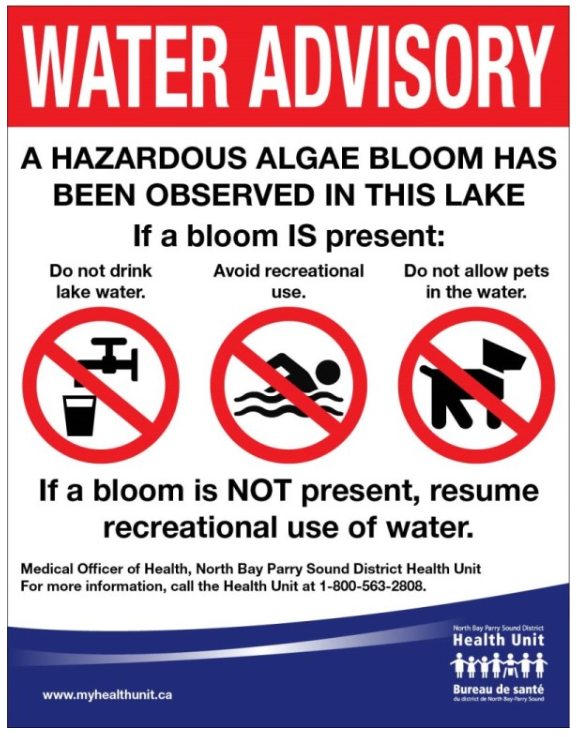
Water Resources
The Township has a practice of removing the beaver dam at the outlet of Wasi Lake every fall; aiming for the first couple of weeks in October. This practice was put in place to build capacity for the spring thaw and mitigate the flooding and erosion of multiple roads to the south of the Lake.
DISCLAIMER: The links and content on this page are for information purposes only and may not be the opinion of the Township of Chisholm staff and/or Council. Any questions about these resources should be directed to the creator of the content and not the municipal office.
Last Confirmed Blue Green Algae in Wasi Lake:
- August 1, 2024.
- August 3, 2023.
Links to more information
North Bay Parry Sound District Health Unit
Blooms can come and go throughout the season. If a test confirms presence of Blue-Green Algae, signs are posted at the beach and boat launch to inform swimmers that there could be a bloom present.
For more information visit:
https://www.myhealthunit.ca/en/health-topics/harmful-algae.aspxThis link opens in a new window

Ministry of the Environment
- If you suspect an algae bloom on the lake you can report it to the Spills Action Centre. The Ministry of the Environment will come out and take a sample to be tested for Blue-Green Algae. The Ministry will send the Township the results. It is important to know that once there is a confirmed Blue-Green Algae Bloom, the ministry will not come out and sample the lake again. For more details on Algae blooms visit https://www.ontario.ca/page/blue-green-algae
Other Resources
- Your Shoreline - http://muskokawaterweb.ca/images/dfo/ShorePrimer-English.pdf
http://naturaledge.watersheds.ca/partners/ - Algae in Ontario https://www.myhealthunit.ca/en/health-topics/harmful-algae.aspx?fbclid=IwAR2jnPHSs2nigTRliY6wB-R7Z0VGUMI37p2m9ngLMlHqMeIQPjxTWeRxevk or https://loveyourlake.ca/wp-content/uploads/2018/05/Algae-in-Ontario-Final-1.pdf
Invasive Species in Ontario
Hundreds of invasive species have infiltrated our lakes, rivers and forests. This puts our native fish, plants and animals and their habitats at risk. After an invasive species arrives it is almost impossible to remove it. This can cause irreparable damage to important habitats and ecosystems. For more information visit https://www.ontario.ca/page/invasive-species-ontario
Visit the below guides on how you can do your part.
Ontario's Invading Species Awareness Program
In 1992, the Ontario Federation of Anglers and Hunters, in partnership with the Ontario Ministry of Natural Resources and Forestry, established the Invading Species Awareness Program in order to address the increasing threats posed by invasive species in Ontario. Our objectives are to generate education and awareness of aquatic and terrestrial invasive species, address key pathways contributing to introductions and/or spread, and facilitate monitoring and early detection initiatives for invasive species found within Ontario.
Invasive Species Act
Enacted in 2015 and amended in 2022 and 2024, the Invasive Species Act provides a framework for identifying, classifying, and managing invasive species in Ontario. As of the amendment in 2024, 28 species and 3 genera are now prohibited, meaning it is illegal to import, transport, possess, or release these species anywhere in Ontario. Additionally, 15 species and 1 genus are restricted, meaning it is illegal to import or release them anywhere in Ontario and illegal to bring them into a conservation reserve or national park. Under the Act, invasive species are non-native species that can cause harm to the environment, economy, and human health.
Invasive Phragmites
Invasive Phragmites (European Common Reed) is an invasive plant causing damage to Ontario’s biodiversity, wetlands and beaches. Invasive Phragmites is a perennial grass that has been damaging ecosystems in Ontario for decades. It is not clear how it was transported to North America from its native home in Eurasia.
Invasive Phragmites is an aggressive plant that spreads quickly and out-competes native species for water and nutrients. It releases toxins from its roots into the soil to hinder the growth of and kill surrounding plants. While it prefers areas of standing water, its roots can grow to extreme lengths, allowing it to survive in relatively dry areas.
Visit Invasive Phragmites | Ontario's Invading Species Awareness Program for more information.
FISHERIES AND OCEANS
- Fish and Fish Habitat Protection Program 1-855-852-8320
- Beaver Dams - Fisheries and Oceans “Interim code of practice: beaver dam removal” https://www.dfo-mpo.gc.ca/pnw-ppe/codes/beaver-dam-barrage-castor-eng.html
Ministry of Natural Resources and Forestry
https://www.ontario.ca/page/ministry-natural-resources-and-forestry
- Forest Fire
- Hunting and Fishing
- Ontario’s Invading Species Awareness Program is a partnership between the Ontario Ministry of Natural Resources and Forestry (MNRF), and the Ontario Federation of Anglers and Hunters (OFAH).
- Report Invasive Plant Species 1-800-563-7711 or visit https://www.invadingspecies.com/